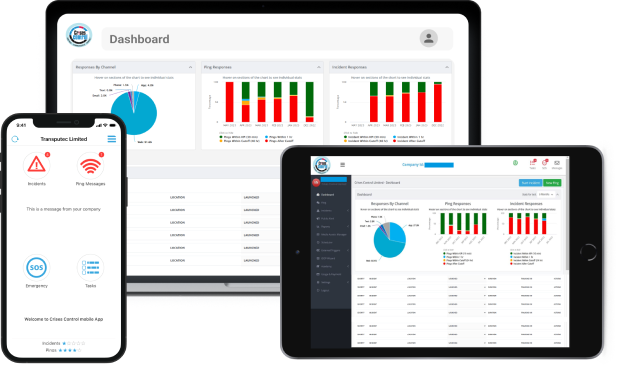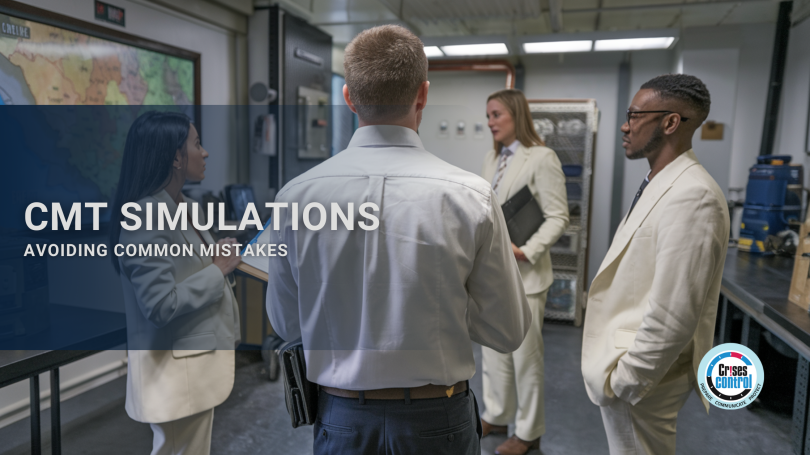Written by Anneri Fourie | Marketing Executive
Effective crisis management isn’t just about having a plan—it’s about testing that plan through well-executed Crisis Management Team (CMT) simulations. These exercises provide organisations with a clear view of their strengths, weaknesses, and areas for improvement. However, many businesses fall short, committing errors that undermine the value of these simulations.
In this blog, we’ll examine common pitfalls organisations encounter during CMT simulations, offer practical solutions, and show how Crises Control can help you elevate your crisis management preparation.
What Are CMT Simulations, and Why Are They Important?
CMT simulations are structured exercises designed to replicate real-world crises. These scenarios test the ability of an organisation’s Crisis Management Team to respond effectively to events such as cyberattacks, supply chain disruptions, or natural disasters. The goal is not only to refine processes, but also to build confidence, teamwork, and resilience.
For businesses, the stakes are high. Unpreparedness can lead to financial losses, reputational damage, and disrupted operations. By conducting regular CMT simulations, organisations can address gaps in their strategies before an actual crisis hits.
Common Mistakes in CMT Simulations and How to Fix Them
1. Creating Unrealistic Scenarios
A common error is designing scenarios that are either too simplistic or entirely disconnected from the business’s actual risk profile. For example, simulating a generic “power outage” without considering the specific vulnerabilities of your operations provides little value.
Solution:
- Conduct a thorough risk assessment to identify realistic threats unique to your industry.
- Use historical data, industry trends, and emerging threats to craft scenarios that challenge your team.
- Leverage Crises Control’s Incident Plan Builder to create bespoke scenarios with actionable steps tailored to your organisation’s risks.
2. Overlooking Cross-Functional Collaboration
Crisis simulations often focus on a single department, such as IT or Operations, neglecting the interconnected nature of modern organisations. In a real crisis, every team—HR, Legal, Finance, and beyond—must work together.
Solution:
- Involve representatives from all key departments in the simulation.
- Define clear roles and responsibilities for each participant, ensuring no critical area is overlooked.
- Use Crises Control’s Task Manager to assign, monitor, and coordinate tasks across teams seamlessly.
3. Poor Communication During Simulations
Communication is the backbone of effective crisis management. Yet, many simulations fail to test how well messages are delivered and received, leading to confusion and delays when it matters most.
Solution:
- Develop robust communication protocols and test them during every simulation.
- Utilise multi-channel communication tools to replicate real-world scenarios.
- Crises Control’s Ping Mass Notification system enables you to send instant alerts to team members, ensuring no one is left in the dark during a simulation.
4. Skipping the Post-Simulation Debrief
Many organisations rush through or entirely skip the debrief stage, missing out on valuable lessons. Without analysing what worked and what didn’t, the exercise becomes a wasted opportunity.
Solution:
- Hold a structured debrief immediately after the simulation, involving all participants.
- Discuss strengths, weaknesses, and actionable improvements.
- Use Crises Control’s Reporting and Audit feature to generate detailed reports on team performance and identify trends to refine future exercises.
5. Ignoring the Human Element
While technology and processes are critical, the human factor often determines success or failure in a crisis. Stress, decision fatigue, and miscommunication can derail even the most robust plans.
Solution:
- Include scenarios that test leadership, teamwork, and decision-making under pressure.
- Incorporate role-playing exercises that reflect high-stakes situations.
- Crises Control’s SOS Panic Button can simulate high-pressure scenarios, helping teams practice rapid responses and decision-making in realistic conditions.
How Crises Control Enhances CMT Simulations
Crises Control is more than just a tool—it’s a comprehensive platform designed to simplify and enhance every aspect of your CMT simulations. Here’s how it can help:
- Incident Plan Builder: Craft tailored, step-by-step plans that reflect your organisation’s specific risks and challenges.
- Task Manager: Ensure seamless coordination by assigning and tracking tasks across departments in real time.
- Ping Mass Notification: Test and refine your communication strategies with instant, multi-channel alerts.
- Reporting and Audit: Gain actionable insights through detailed performance reports, enabling continuous improvement.
- SOS Panic Button: Simulate high-pressure scenarios to train your team in handling stress and making critical decisions.
With Crises Control, businesses can transform their CMT simulations into powerful training exercises that prepare teams for any challenge.
The Benefits of Regular CMT Simulations for Businesses
- Enhanced Preparedness: Teams gain the skills and confidence to respond effectively to crises.
- Improved Communication: Regular practice ensures that protocols are clear and efficient.
- Risk Mitigation: Identifying and addressing weaknesses early reduces the impact of real crises.
- Business Continuity: A well-prepared CMT ensures minimal disruption to operations during emergencies.
Why Avoiding These Mistakes Matters
The difference between a successful crisis response and a failed one often comes down to preparation. Avoiding common mistakes in CMT simulations not only builds a stronger Crisis Management Team, but also protects your organisation’s reputation, finances, and people.
By focusing on realistic scenarios, fostering collaboration, and prioritising communication, you can ensure your simulations are as effective as possible.
Conclusion: Be Proactive, Not Reactive
Preparing your Crisis Management Team through effective CMT simulations is one of the best investments your organisation can make. By addressing common pitfalls and implementing solutions, you can build a resilient, confident team ready to face any challenge.
Crises Control offers the tools and expertise to take your simulations to the next level. From crafting tailored scenarios to enabling seamless coordination and communication, our platform empowers you to be proactive in your crisis management efforts.
Contact us today for a free personalised demo and see how Crises Control can transform your crisis management strategy.
Request a FREE Demo

